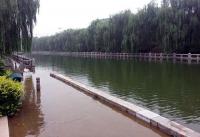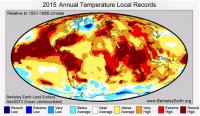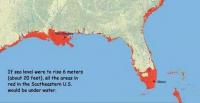-
Worst flooding since 1998 leaves $33 billion economic toll in China

The new Global Catastrophe Recap report, covering July 2016 disasters, reveals that much of China endured substantial seasonal “Mei-Yu” rainfall that led to a dramatic worsening of flooding along the Yangtze River Basin and in the country’s northeast. Total combined economic losses were estimated at $33 billion. Meanwhile, the United States recorded six separate outbreaks of severe convective storms and flash flooding from the Rockies to the East Coast. Total combined economic losses were minimally estimated at $1.5 billion. Only 2 percent of China damage is covered by insurance, compared to nearly 70 percent for U.S. storms.
-
-
$40 million funding opportunity for homeland security quantitative analysis COE
DHS S&T the other day announced a $40 million funding opportunity for an institution to lead a new DHS Center of Excellence (COE) for Homeland Security Quantitative Analysis. This new COE will conduct end user-focused research to enhance the application of analytic tools that support real-time decision making and address homeland security-related threats and hazards.
-
-
Melting ice sheet could release frozen cold war-era radioactive waste
Camp Century, a U.S. military base built within the Greenland Ice Sheet in 1959, was decommissioned in 1967, and its infrastructure and waste were abandoned under the assumption they would be entombed forever by perpetual snowfall. But climate change has warmed the Arctic more than any other region on Earth, and as portion of the ice sheet covering Camp Century melt, the camp’s infrastructure will become exposed, and any remaining biological, chemical, and radioactive waste could re-enter the environment.
-
-
Making climate change summaries suitable for “grownups,” but accessible to policymakers
Researchers examined the writing and editing procedures by which the Intergovernmental Panel on Climate Change creates summaries of their findings for policymakers. Despite recent critiques that these summaries are too difficult for non-experts, the researchers found them comparable to reference texts in terms of reading comprehension level. Nevertheless, the researchers also suggest ways that the summary reports could be improved by using less jargon and more cohesive language to link the ideas they contain.
-
-
“Liquid fingerprinting” technique identifies unknown liquids instantly
A new company — Validere — will commercialize sensing technology invented at Harvard University that can perform instant, in-field characterization of the chemical make-up and material properties of unknown liquids. Validere aims to develop the licensed technology, called Watermark Ink (W-INK), into a pocket-sized device that could be used by first responders to quickly identify chemical spills, or by officials to verify the fuel grade of gasoline right at the pump.
-
-
Adaptation to climate risks: Political affiliation matters
A new study reveals that those who affiliate with the Democratic Party have different views than those who vote Republican on the following issues: the likelihood of floods occurring, adopting protection measures, and expectations of disaster relief from the government.
-
-
Successful flight test of UAV with mass-actuated controls
For the first time an unmanned aerial vehicle that uses moving weights in its wings, instead of traditional control surfaces or ailerons to turn, was successfully flight-tested. A recently graduated University of Texas at Arlington student used existing UTA research to design, build, and test a UAV that uses mass actuation — weights that move back and forth within the wings to change the center of gravity from side to side — to turn while airborne.
-
-
Swimming, crawling, climbing robot to help in security, search & rescue missions
Researchers have developed the first single actuator wave-like robot (SAW). SAW can climb over obstacles or crawl through unstable terrain like sand, grass, and gravel, reaching a top speed of 22.5 inches. The robot will be useful for traveling through the intestine for imaging and biopsies, and for infiltrating problematic, complex security areas, such as tunnels, destroyed buildings, and pipes.
-
-
2015 surpassed 2014 as the warmest year since at least the mid-to-late nineteenth century

A new State of the Climate report confirmed that 2015 surpassed 2014 as the warmest year since at least the mid-to-late nineteenth century. Last year’s record heat resulted from the combined influence of long-term global warming and one of the strongest El Niño events the globe has experienced since at least 1950. The report found that most indicators of climate change continued to reflect trends consistent with a warming planet. Several markers such as land and ocean temperatures, sea levels, and greenhouse gases broke records set just one year prior.
-
-
Climate risk and the fossil fuel industry
Burning coal, oil, and natural gas is responsible for two-thirds of the world’s greenhouse gas emissions. Yet these same fuels are also the economic mainstay of resource-rich countries and the world’s largest companies. According to a new study, this means that climate-change relief actions represent danger for the fossil fuel business.
-
-
Battelle awards over $300,000 to boost STEM education
Battelle — operator of Pacific Northwest National Laboratory — has boosted a network of STEM education organizations, awarding over $300,000 in grants to benefit K-12 schools, higher education institutions, community partnerships, and other non-profit organizations.
-
-
Remotely disabling non-cooperative vehicles
As they strive to keep the public safe, one of the key challenges facing European security services is the ability to control and stop, at distance, non-cooperative vehicles posing a threat. However, this ability presents more than a technical challenge. To comply with EU legislation, as well as adhere to ethical concerns, the technology would also have to be safe for the user, the driver (and passengers), as well as members of the public and the material infrastructure of the surrounding environment. In lab bench testing, researchers evaluated signal frequency, waveform, and duration — principally of electromagnetic pulses (EMP) and high power microwaves (HPM) — to determine which could best disrupt the functioning of a vehicle’s electronic components.
-
-
Electric grid vulnerabilities in extreme weather areas
Climate and energy scientists at the DoE’s Oak Ridge National Laboratory have developed a new method to pinpoint which electrical service areas will be most vulnerable as populations grow and temperatures rise. The scientists’ integrated approach – combining ORNL’s unique infrastructure and population datasets with high-resolution climate simulations run on the lab’s Titan supercomputer — identifies substations at the neighborhood level and determines their ability to handle additional demand based on predicted changes in climate and population.
-
-
New Prize in Food and Agriculture Sciences announced
The National Academy of Sciences announced the creation of a new prize, the NAS Prize in Food and Agriculture Sciences, to be presented annually beginning in 2017 with an award of $100,000. The NAS Prize in Food and Agriculture Sciences will recognize research by a mid-career scientist at a U.S. institution who has made an extraordinary contribution to agriculture or to the understanding of the biology of a species fundamentally important to agriculture or food production.
-
-
Sea-level rise threatens many coastal U.S. military bases

The U.S. Armed Forces depend on safe and functional bases to protect the U.S. national security. Sea levels are rising as global warming heats up the planet, and many military bases along the U.S. East Coast and Gulf of Mexico are at risk of permanently losing land to the ocean in the decades ahead. As the seas rise, high tides will reach farther inland. Tidal flooding will become more frequent and extensive. When hurricanes strike, deeper and more extensive storm surge flooding will occur. The United States must thus prepare for the growing exposure of its military bases to sea level rise.
-
More headlines
The long view
New Technology is Keeping the Skies Safe
DHS S&T Baggage, Cargo, and People Screening (BCP) Program develops state-of-the-art screening solutions to help secure airspace, communities, and borders
Factories First: Winning the Drone War Before It Starts
Wars are won by factories before they are won on the battlefield,Martin C. Feldmann writes, noting that the United States lacks the manufacturing depth for the coming drone age. Rectifying this situation “will take far more than procurement tweaks,” Feldmann writes. “It demands a national-level, wartime-scale industrial mobilization.”
How Artificial General Intelligence Could Affect the Rise and Fall of Nations
Visions for potential AGI futures: A new report from RAND aims to stimulate thinking among policymakers about possible impacts of the development of artificial general intelligence (AGI) on geopolitics and the world order.
Smaller Nuclear Reactors Spark Renewed Interest in a Once-Shunned Energy Source
In the past two years, half the states have taken action to promote nuclear power, from creating nuclear task forces to integrating nuclear into long-term energy plans.
Keeping the Lights on with Nuclear Waste: Radiochemistry Transforms Nuclear Waste into Strategic Materials
How UNLV radiochemistry is pioneering the future of energy in the Southwest by salvaging strategic materials from nuclear dumps –and making it safe.
Model Predicts Long-Term Effects of Nuclear Waste on Underground Disposal Systems
The simulations matched results from an underground lab experiment in Switzerland, suggesting modeling could be used to validate the safety of nuclear disposal sites.
